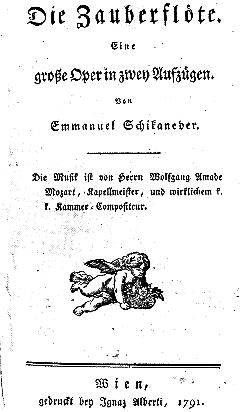"The Magic Flute" - Bro. Alberti and the Frontispiece of the Libretto on the Occasion of the First Performance in the Year 1791 (Page 2).
 |
|
When we hear the word "Magic Flute" (Zauberflöte), we certainly think about lovely music, written by the freemason Mozart. We remind perhaps stage scenes and costumes. At the first performance special importance was laid on the providing with clothes. Mr. Gayl was the scene-painter, and Mr. Neßthaler was responsible for decoration. In 1791 stage director Schikaneder made the text for the opera, assisted by actor Gieseke, both freemasons. At that time magic-operas were fashionable, but the masonic touch, perceptible for the initiated at many points, gives the text a special note even today, especially at the beginning of act two. The philosopher Hegel supported the many slandered text of the work when he said: "How often you can hear for instance the idle talk that the text of the "Magic Flute" was too miserable; however this clumsy piece of work belongs to the praiseworthy opera books. After some crazy, fantastic and silly production, Schikaneder here had found the right way. The empire of the night, the queen, the sun empire, the mysteries, the initiation, the wisdom, love, the examinations and thereby a sort of a mediocre moral which is excellent in its generality - all this, with the depth of the charming sweetness and soul of the music, widens and fills the fantasy and warms the heart." The day of the first performance, a book about the opera was available. This book with a careful editing of the complete text, was manufactured in a leading printing-house of Vienna which belonged to the freemason Ignaz Alberti (1760-1794). In 1789 he was independent as a publisher. Alberti chooses for the text a printing-type where he can change four sizes of types within the sentence: The biggest one for the names of the persons, the second biggest for the prose dialogues, a smaller one for the singing parts and the smallest for stage directions. As illustration Alberti adds two etchings. One is in the book in front of Papageno's entrance song and shows the bird-captor in his featherdress with a cage on his back. |